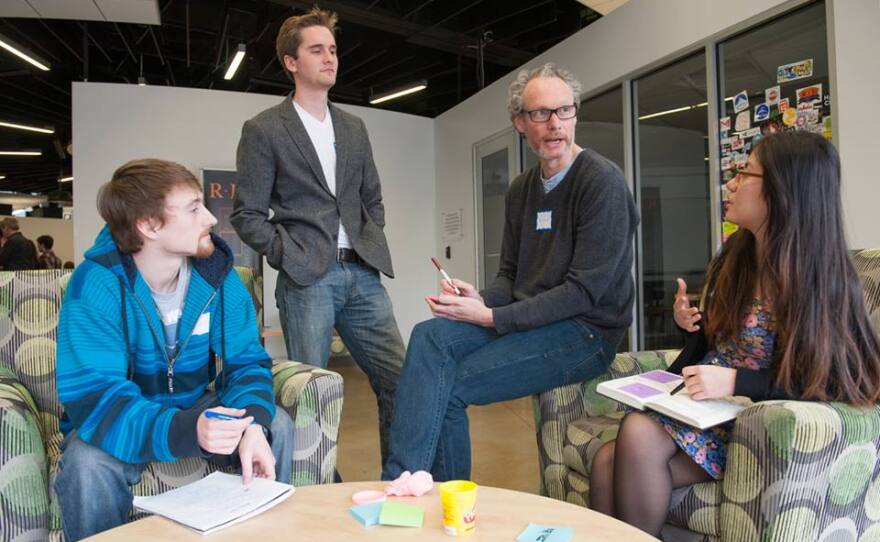The engineering and design students on stage presenting their concept have been working on this prototype for a grand total of two days. The whirlwind workshop, requires student teams to comprehensively understand medical problems, come up with viable ideas, and create real solutions, all in less than 36 hours.
“This is a deep dive,” says Amos Scully, a professor in the Industrial Design program at RIT who is serving as the team’s faculty coach.
Physical Therapist Kelly Schauf has come to the IdeaLab after noticing many of her stroke patients needed help working on their posture outside her direct watch. She hopes students can create a wearable device that would use noise to alert patients when they’re leaning too far to one side or the other. To help students imagine a real patient, Schauf creates a character recovering from a stroke, whom she calls Dave.
Schauf gives the students enough details about Dave to visualize him. He’s middle-aged, slim, and walking with a cane. “He’s back home, but he has adopted some poorer movement patterns, so he’s relying on the cane for support and he’s favoring his left leg,” Schauf explains.
One team member quickly interjects, noting the comparison between Dave and the character Doug Stamper on the popular Netflix series, House of Cards. As the brainstorming continues, Dave morphs into Doug (by the time the students present their idea on stage, a still of Doug from the show appears in their slideshow).
When Scully suggests Dave’s posture should be fine because he uses a cane, Schauf delves deeper into her well of experience as a physical therapist. “You would be surprised,” she says. “There are some patients like Doug that are using this cane and they’re hiking their hip to get their leg through or they’re shortening their spine or their leaning this way to do it.”
After the crash course in kinesiology, the students take the afternoon to “ideate.” They suggest everything from a simple app for an iPhone worn around the neck to something that would directly change the impulses within the brain. Schauf quickly dismisses that idea; neurosurgery is off the table.
By 1:00 the next afternoon, the students are presenting their physical prototype: a vest with sensors that can detect tilted posture and a vibrating that vibrates more intensely the further the patient leans. Once the patient is so far from a straight position that he might fall, the device starts to make noise. The vest also logs data to help patients understand their posture patterns.
Scully, the faculty coach, thinks the IdeaLab’s partnership with health system helps students see how their energy and ideas can benefit someone, rather than the bottom line. “There’s something compelling about students not making a project for some kind of company, that they’re actually doing it for the healthcare system,” he says.
Past IdeaLab projects have become reality, like a mobile centrifuge unit for blood samples now in use by Rochester Regional Health System. This project was developed after phlebotomists noticed a high rate of false positive blood sample due to the time the samples sat idle while they drove them back to the lab. Students created a system to allow centrifuging in the phlebotomists’ cars. The result was a drop in the rate of bad samples from 5% to 0, which saves the system nearly $100,000 a year.
Team Spynalign – the posture vest inventors - haven’t made a business plan yet. During the question and answer portion of their presentation, a facilitator suggests their prototype might work for golfers too. That commercial opportunity could make the project more likely to succeed by bringing the price point down.
At the end of the weekend, Dr. Richard DiMartino, director of the Simone Center encourages students to continue their projects, even offering a small amount of start-up funding.
Industrial design student Jeremiah Eyster from Team Spynalign sees the opportunity as too good to give up now. “I think we can all see a lot of potential in it and so it wouldn’t be smart to back out when it seems like something that is in reach,” he said.







